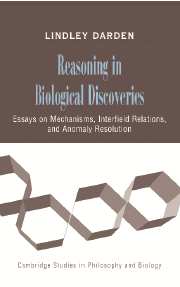 Reasoning in Biological Discoveries
Reasoning in Biological Discoveries Introduction
Published online by Cambridge University Press: 31 August 2009
Summary
This book discusses reasoning strategies for discovery that are exemplified in numerous biological cases. Scientific discovery should be viewed as an extended, piecemeal process with hypotheses undergoing iterative refinement. Construction, evaluation, and revision are tightly connected in ways that philosophers of science have often not recognized, given their neglect of reasoning in hypothesis construction and revision. Examination of historical cases from twentieth-century biology reveals reasoning strategies that could have produced the changes that did occur. Such critically examined reasoning strategies constitute compiled hindsight gleaned from these past episodes. Examples come from the fields of molecular biology, biochemistry, immunology, neuroscience, and evolutionary biology. Making reasoning strategies explicit shows that they are not merely descriptions of unique historical changes or unwarranted overly general prescriptions. They are advisory. They may be of use as metascientific hypotheses in philosophical and historical analyses of scientific reasoning, of use in future empirical and computational biological research, and of use in science education. Hence, one goal of this book is to make explicit reasoning strategies for construction, evaluation, and revision of scientific hypotheses.
Biologists often seek to discover mechanisms. Knowing what is to be discovered aids the extended process of discovery. The examination of the nature and means of representing biological theories aids analysis of reasoning in their discovery. What play the roles of theories in molecular biology, for example, are diagrammatically represented sets of mechanism schemas for such widely found mechanisms as DNA replication, protein synthesis, and many varieties of gene regulation.
- Type
- Chapter
- Information
- Reasoning in Biological DiscoveriesEssays on Mechanisms, Interfield Relations, and Anomaly Resolution, pp. 1 - 10Publisher: Cambridge University PressPrint publication year: 2006


